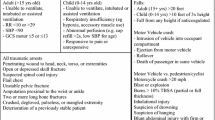Abstract
Introduction
Trauma center radiologists vary widely in the degree to which they provide secondary interpretations for transferred patients’ advanced imaging. A general perception of uncertainty over reimbursement for these exams often results in reluctance to provide routine overreads. The purpose of this study is to assess the difference in reimbursement rates between primary interpretations and secondary interpretations in the emergency department (ED) setting.
Materials and methods
Billing records for the three CT procedures most commonly performed in a single, major level 1 trauma center ED from January 1, 2021, to December 31, 2021, constituted the dataset. Gross charges, total receipts, and payer status were recorded for each exam, and reimbursement rates calculated.
Results
In total, 19,754 exams met the inclusion criteria. Primary interpretation was performed on 16,507 (83.6%) exams and secondary interpretation on 3247 (16.4%). For the three CPT codes examined, the average reimbursement percentage was 32.9% for primary interpretation and 43.5% for secondary interpretation. The average reimbursement percentage for commercial payers was 56.5% for primary interpretation and 65.9% for secondary interpretation. The average reimbursement percentage for Health Insurance Exchange payers was 58.5% for primary interpretation and 59.5% for secondary interpretation. The average reimbursement percentage for Medicaid was 24.7% for primary interpretation and 39.9% for secondary interpretation. The average reimbursement percentage for Medicare was 31.1% for primary interpretation and 30.2% for secondary interpretation. The average reimbursement percentage for self-paying patients was 2.3% for primary interpretation and 3.5% for secondary interpretation.
Conclusion
Regardless of payer status, reimbursement for secondary interpretation of the three most common transfer patients’ CT exams is near or greater than that of primary interpretations.
Similar content being viewed by others
References
Robinson JD, McNeeley MF (2012) Transfer patient imaging: a survey of members of the American Society of Emergency Radiology. Emerg Radiol 19(5):447–454
Halin N (2021) Trauma overreads. : engage, American College of Radiology. https://engage.acr.org/communities/community-home/digestviewer/viewthread?GroupId=145&MessageKey=b307f00b-26d7-4c6f-a9c6-8086b3aa012d&CommunityKey=aa0dae1a-e40d-4682-afb8-57d722d6562e&tab=digestviewer. Accessed June 1, 2022
Sung JC, Sodickson A, Ledbetter S (2009) Outside CT imaging among emergency department transfer patients. J Am Coll Radiol : JACR 6(9):626–632
Quick JA, Bartels AN, Coughenour JP, Barnes SL (2013) Trauma transfers and definitive imaging: patient benefit but at what cost? Am Surg 79:301–304
Holmes JF, Siglock BG, Corwin MT, Johnson MA, Salcedo ES, Espinoza GS et al (2017) Rate and reasons for repeat CT scanning in transferred trauma patients. Am Surg 83(5):465–469
McNeeley MF, Gunn ML, Robinson JD (2013) Transfer patient imaging: current status, review of the literature, and the Harborview experience. J Am Coll Radiol 10:361–367
Rosenkrantz AB, Smith SW, Recht MP, Horwitz LI (2020) Perceptions of radiologists and emergency medicine providers regarding the quality, value, and challenges of outside image sharing in the emergency department setting. AJR Am J Roentgenol 214(4):843–852
Robinson JD, Linnau KF, Hippe DS, Sheehan KL, Gross JA (2018) Accuracy of outside radiologists’ reports of computed tomography exams of emergently transferred patients. Emerg Radiol 25(2):169–173
Robinson JD, Kessler R, Vrablik ME, Vrablik MC, Hippe DS, Hall MK, et al (2022) Transfer patient imaging: assessment of the impact of discrepancies identified by emergency radiologists. J Am Coll Radiol 19:1244–1252
Lu MT, Hallett TR, Hemingway J, Hughes DR, Hoffmann U, Duszak R (2016) Secondary interpretation of CT examinations: frequency and payment in the Medicare fee-for-service population. J Am Coll Radiol 13(9):1096–1101
Jeffers A, Saghir A, Camacho M (2012) Formal reporting of second-opinion CT interpretation: experience and reimbursement in the emergency department setting. Emerg Radiol 19(3):187–193
Author information
Authors and Affiliations
Corresponding author
Ethics declarations
Conflict of interest
The authors have no financial conflict of interests to disclose. JDR is a non-shareholder employee. AD is a student.
Additional information
Publisher's note
Springer Nature remains neutral with regard to jurisdictional claims in published maps and institutional affiliations.
Rights and permissions
Springer Nature or its licensor (e.g. a society or other partner) holds exclusive rights to this article under a publishing agreement with the author(s) or other rightsholder(s); author self-archiving of the accepted manuscript version of this article is solely governed by the terms of such publishing agreement and applicable law.
About this article
Cite this article
Robinson, J.D., Dahl, A. Transfer patient imaging: secondary interpretation reimbursement. Emerg Radiol 30, 93–97 (2023). https://doi.org/10.1007/s10140-022-02107-4
Received:
Accepted:
Published:
Issue Date:
DOI: https://doi.org/10.1007/s10140-022-02107-4




